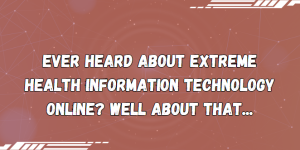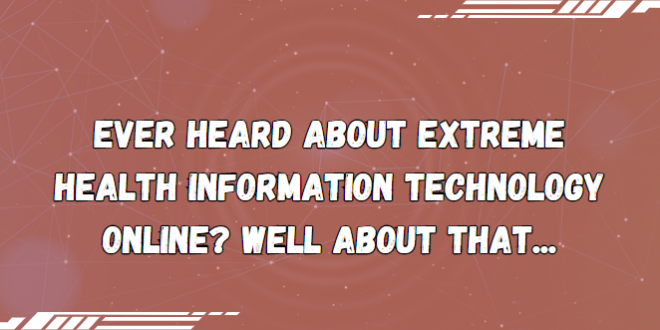When it comes to health information technology, the online world offers a vast array of resources and platforms. From health apps to wearable devices, there’s no shortage of tools and information available to help individuals manage their well-being. However, with such an abundance of options, it’s important to approach extreme health information technology online with caution and critical thinking. In this article, we will explore the potential risks and benefits of extreme health information technology and provide insights to help you navigate this digital landscape wisely.

1. The Allure of Extreme Health Information Technology
Extreme health information technology refers to the use of advanced and cutting-edge technologies to monitor and manage various aspects of health and well-being. It encompasses devices and apps that track everything from sleep patterns and heart rate to calorie intake and stress levels. The allure of these technologies lies in the promise of gaining valuable insights into one’s health and making data-driven decisions to improve overall well-being.
2. The Pitfalls of Relying Solely on Technology
While extreme health information technology can provide useful data, it’s essential to recognize its limitations. Relying solely on technology for health management can create a false sense of security and overlook the importance of professional medical advice. Technology should be seen as a tool to complement traditional healthcare practices rather than a replacement for expert guidance.
3. Accuracy and Reliability Concerns
One of the primary concerns with extreme health information technology is the accuracy and reliability of the data it provides. These devices and apps may not always deliver precise measurements or provide a comprehensive understanding of an individual’s health. Factors such as device calibration, user error, and external influences can affect the accuracy of the information gathered.
4. Privacy and Data Security
Using extreme health information technology often involves sharing personal health data with third-party platforms and services. Privacy and data security become crucial considerations in this context. It’s important to research and choose reputable and secure platforms that prioritize the protection of sensitive health information.
5. The Role of Professional Medical Advice
Extreme health information technology should never replace the guidance and expertise of healthcare professionals. While self-monitoring and tracking can be beneficial, it’s crucial to consult with a healthcare provider who can interpret the data in the context of an individual’s unique medical history and provide personalized recommendations.
6. Finding a Balanced Approach
Instead of solely relying on extreme health information technology, it’s advisable to adopt a balanced approach to health management. This includes integrating technology with regular visits to healthcare professionals, seeking evidence-based information, and prioritizing overall well-being rather than fixating on specific data points.
7. Educating Yourself on Health Information Technology
To make informed decisions about using extreme health information technology, it’s important to educate yourself about the different options available. Understand the limitations and potential risks associated with specific devices and apps. Look for scientific studies, user reviews, and expert opinions to gauge the effectiveness and reliability of the technology.
8. Assessing Personal Goals and Needs
Not everyone requires the same level of health information technology. Assess your personal goals and needs to determine if extreme tracking and monitoring align with your overall well-being objectives. It’s important to prioritize your mental and emotional health alongside physical health, and to ensure that technology supports a balanced and holistic approach.
9. Evaluating the Impact on Mental Health
Constant monitoring and tracking of health-related data can potentially lead to increased anxiety, obsession, or stress. It’s crucial to evaluate the impact of extreme health information technology on your mental health and well-being. If it starts to have a negative effect, consider scaling back or seeking professional support.
10. Collaborating with Healthcare Professionals
To maximize the benefits of extreme health information technology, it’s important to involve healthcare professionals in the process. Share the data you collect with your healthcare provider and discuss how it can inform your overall health management plan. This collaboration ensures a comprehensive and integrated approach to your well-being.
11. Making Informed Choices
When selecting and using extreme health information technology, prioritize informed choices. Consider factors such as user-friendliness, compatibility with your lifestyle, privacy policies, and data sharing practices. Opt for devices and apps that align with your values and contribute positively to your overall health goals.
12. Listening to Your Body
While extreme health information technology can provide valuable insights, it’s essential to listen to your body and trust your intuition. Pay attention to how you feel physically, emotionally, and mentally. Use technology as a tool to complement your self-awareness rather than relying solely on external data.
13. Striving for a Healthy Relationship with Technology
Building a healthy relationship with extreme health information technology involves setting boundaries and practicing moderation. Avoid becoming overly reliant on technology for self-worth or validation. Use it as a tool to enhance your well-being, but remember that your worth and health extend beyond the data generated by a device or app.
14. Potential Benefits of Extreme Health Information Technology
While there are risks and limitations, extreme health information technology does offer potential benefits. It can increase awareness of health behaviors, facilitate self-monitoring, provide motivation for positive lifestyle changes, and create opportunities for proactive health management.
15. Embracing a Holistic Approach
Extreme health information technology should be seen as part of a holistic approach to health and well-being. It should complement other self-care practices such as regular physical activity, balanced nutrition, stress management, and nurturing social connections. Embrace a comprehensive approach that addresses multiple aspects of your well-being.
16. Reflecting on Personal Values
Before diving into extreme health information technology, take a moment to reflect on your personal values and priorities. Ensure that the pursuit of health technology aligns with your values and contributes positively to your overall quality of life. Avoid getting caught up in trends or peer pressure.
17. Consulting with Trusted Sources
When seeking information about extreme health information technology, consult trusted sources such as healthcare professionals, reputable websites, and scientific literature. Avoid relying solely on anecdotal experiences or unverified claims. Critical thinking and skepticism are important when evaluating the validity of health-related information.
18. Striking a Balance
Strive for a balance between utilizing extreme health information technology and living in the present moment. Remember that technology is a tool to support your well-being, not an end in itself. Don’t let the pursuit of data overshadow the joy of experiencing life and focusing on overall happiness and fulfillment.
19. Recognizing Individual Differences
It’s important to acknowledge that different individuals have different preferences and needs when it comes to extreme health information technology. What works for one person may not work for another. Embrace your uniqueness and choose the approach to health management that feels most authentic and meaningful to you.
20. Embracing the Digital Health Revolution Responsibly
Extreme health information technology offers exciting possibilities for individuals to take charge of their health and well-being. However, it’s essential to approach it with caution, critical thinking, and a balanced perspective. By educating yourself, involving healthcare professionals, and prioritizing holistic well-being, you can harness the potential benefits of extreme health information technology while safeguarding your mental, emotional, and physical health.
 Spacetimes A collection of the latest news and information from various trusted sources
Spacetimes A collection of the latest news and information from various trusted sources
